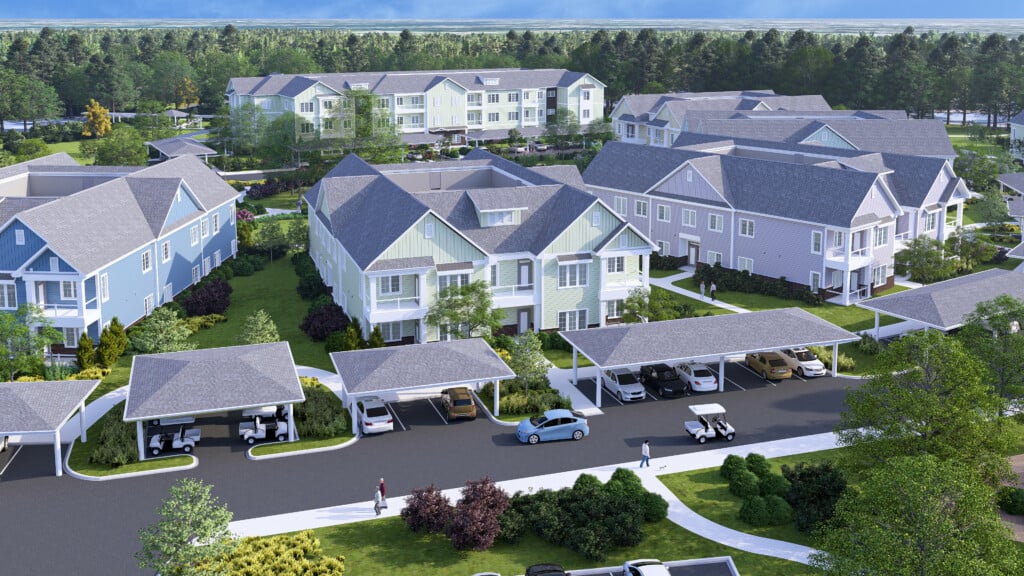“We Have Nowhere to Stay and Don’t Know What to Do”: 20 Years of Sheltering Our Homeless Neighbors
20 years ago this month, Good Shepherd Center opened its Night Shelter with more than 100 beds for homeless men, women, and families with children. It was a response to unmet demand for emergency beds across the Wilmington area and the culmination of a community-wide fundraising effort on the part of congregations, businesses, foundations and individuals. What began as a modest safety net has become a critical bridge for thousands of Cape Fear residents navigating a housing market that too often feels out of reach. From the beginning, we’ve served the diverse array of neighbors who find themselves without housing, whether for a brief episode or an extended length of time. They’re veterans and seniors, persons with disabilities, the working poor, and parents with children, from babies to teenagers.
Just as in 2005, the vast majority of those who seek shelter with us today are in crisis due to economic circumstances, not primarily addiction or mental illness. The mismatch between their income and the income they need to afford and reliably pay for housing leaves them vulnerable to even minor hiccups—a car breakdown, missed days of work due to illness—quickly spiraling into rental delinquency and then eviction. What’s different today is the rising number of households who have never had to seek assistance before but who now find themselves in a desperate situation.
“I just don’t know how we ended up here… I never thought this would happen to us.”
These days at Good Shepherd, we hear words like these with growing frequency. More and more people are walking through our doors who never imagined they would be here. They are teacher assistants, grandparents, healthcare aides, and service workers—neighbors who once felt secure but are now being pushed into crisis. And increasingly, it is families arriving for the very first time—frightened, exhausted, and unsure of what to do next.
The numbers tell us what our eyes and ears already know: homelessness is rising, and it’s reaching people who never expected it. Nationally, the sharpest increase was among families, with nearly 150,000 children losing a stable place to sleep. That’s enough children to fill every classroom in New Hanover County more than five times over.
Why does that matter here? Because those national shifts are already reshaping life in the Cape Fear region. When family homelessness spikes across the country, it isn’t an abstract headline—it translates into more parents and children arriving at Good Shepherd unsure where to begin. It means classrooms in the region have students preoccupied with where their family will sleep that night. It means neighbors who thought they were safe suddenly finding themselves part of a national story playing out locally.
In July 2025, our local Homeless Continuum of Care reported that 86% of the people who became homeless across New Hanover, Brunswick, and Pender Counties last year were experiencing it for the first time—up dramatically from 60% in 2020. The primary driver of this trend? Rising housing costs, not only making thousands of households vulnerable to housing loss but also crowding out available income for other necessities like food and health care. In other words, nearly nine out of ten of our homeless neighbors are not the chronically unhoused individuals many picture. They are first-timers—families blindsided by rent hikes, older adults on fixed incomes priced out of the local market, and working people suddenly unable to make ends meet.
The pressures behind these numbers are painfully familiar to anyone living here. Today, 34% of households in New Hanover County are cost-burdened, spending more than 30% of their income just to keep a roof overhead—that’s over 33,800 households struggling to stay afloat. Renters feel it most keenly: more than half of renter households (54%) are in that stress zone. This isn’t a distant crisis; it touches people all around us—coworkers, classmates’ parents, fellow congregants, and neighbors who never imagined they’d be so close to losing their home. Service providers across the Cape Fear region are now responding to a very different challenge: supporting working families living in their cars, in motels, or doubled-up with relatives—people who never expected to be in such a situation.
The Housing Math Doesn’t Work — And Why It Matters in the Cape Fear Region
Wilmington’s housing market has become unsustainable for many. The fair market rent for a modest two-bedroom apartment now exceeds $1,500 a month, requiring an hourly wage of more than $30 to avoid being cost-burdened. Yet many of our community’s backbone workers—teacher assistants, hospitality staff, and home health aides—earn less than half that. Families juggle two or three jobs and still come up short. Seniors and adults with disabilities on fixed incomes are priced out altogether.
And the shortage of affordable homes is even more stark. As of early 2025, New Hanover County faced a shortfall of 7,377 affordable rental units—6,267 in Wilmington and another 1,795 across the rest of the county—for households earning less than 50% of Area Median Income. For those earning under 30% of AMI, the squeeze is suffocating. Meanwhile, the median home price has climbed to $540,000, shutting the door to homeownership for first-time buyers and working families who once dreamed of stability through owning a home.
In this environment, eviction doesn’t just displace—it destabilizes. Families who have never needed help before suddenly find themselves asking, “Where do we start?” The shock of first-time homelessness is not just losing four walls, it’s losing a sense of belonging, identity, and direction in a community they’ve always called home.
What We’re Doing — And What Still Needs to Be Done
At Good Shepherd, we know the housing crisis can feel overwhelming. But we also know progress is possible. Every day, our team of case managers works one-on-one with individuals and families, helping them navigate a system that can feel impossible to enter alone. It’s not just paperwork—it’s advocacy with landlords, guidance on budgets, connecting people to healthcare or benefits, and steady encouragement at moments when stability feels out of reach.
This personalized approach makes a difference. In the past month alone, 13 households transitioned from homelessness into stable housing through the support of Good Shepherd’s case managers. In a housing market where rents climb and supply remains tight, that success is proof: with the right support, first-time homeless families can find their way home.
And as we celebrate 20 years of the Night Shelter this October, we are reminded that emergency shelter is more than a place to rest—it’s a launch point. Over two decades, thousands of men, women, and families have moved from those shelter beds into permanent housing, proving that with the right support, a night of safety can spark a new beginning. The anniversary is both a celebration of what’s been accomplished and a call to continue building pathways out of crisis for the next 20 years.
But our work does not stop at the shelter door. Good Shepherd also advocates for systemic solutions—championing policies and partnerships that increase affordable housing across the Cape Fear region. We know that until more units are built and preserved, families will continue to cycle into crisis. And it’s why we speak up for investments in affordable and workforce housing, ensuring that the backbone workers of our community—teachers, healthcare aides, service staff, and others—can live where they work.
Indeed, until the housing shortage eases and the cost of living stabilizes, first-time homelessness will remain a defining challenge of the Cape Fear. Our mission is to make sure that when a neighbor says, “We don’t know what to do,” the answer is clear: Good Shepherd will walk with you until you find home.
A Community at a Crossroads
The stark increase in first-time homelessness should stir empathy—and urgency. It is happening to our neighbors, coworkers, and classmates. And while the numbers are daunting, the story is not one of inevitability. Communities that act quickly, prevent evictions before they happen, and scale Rapid Rehousing—programs that help families move into housing quickly with short-term support—show us that homelessness can be made rare, brief, and non-recurring. The question is no longer whether we can solve homelessness—it’s whether we will.
Here in the Cape Fear, we already have the tools, the knowledge, and the partnerships to turn the tide. What remains is choosing, together, to act. Every meal shared, every landlord who opens a door, every case manager walking alongside a family proves that change is possible.
This October, as Good Shepherd’s Night Shelter marks 20 years, we celebrate not only the thousands of lives touched but also the countless community members—donors, volunteers, and partners—who have made this important work possible. The milestone is a reminder that when we tackle housing crisis as a collective, we create a Cape Fear community with the promise of a real quality of life for all of its residents.



